1. Sabbagh J, McConnell RJ, McConnell MC. Posterior composites: Update on cavities and filling techniques. J Dent. 2017; 57:86–90. DOI:
10.1016/j.jdent.2016.11.010. PMID:
27889605.
3. Lynch CD, Opdam NJ, Hickel R, Brunton PA, Gurgan S, Kakaboura A, Shearer AC, Vanherle G, Wilson NH. Guidance on posterior resin composites: Academy of Operative Dentistry - European Section. J Dent. 2014; 42:377–83. DOI:
10.1016/j.jdent.2014.01.009. PMID:
24462699.
4. Banerjee A. Minimal intervention dentistry: part 7. Minimally invasive operative caries management: rationale and techniques. Br Dent J. 2013; 214:107–11. DOI:
10.1038/sj.bdj.2013.106. PMID:
23392023.
5. Ericson D, Kidd E, McComb D, Mjör I, Noack MJ. Minimally Invasive Dentistry - concepts and techniques in cariology. Oral Health Prev Dent. 2003; 1:59–72. PMID:
15643750.
6. Tassery H, Levallois B, Terrer E, Manton DJ, Otsuki M, Koubi S, Gugnani N, Panayotov I, Jacquot B, Cuisinier F, Rechmann P. Use of new minimum intervention dentistry technologies in caries management. Aust Dent J. 2013; 58(Suppl 1):40–59. DOI:
10.1111/adj.12049. PMID:
23721337.
7. Casagrande L, Laske M, Bronkhorst EM, Huysmans MCDNJM, Opdam NJM. Repair may increase survival of direct posterior restorations - A practice based study. J Dent. 2017; 64:30–6. DOI:
10.1016/j.jdent.2017.06.002. PMID:
28602850.
8. Staehle HJ, Wohlrab T, Saure D, Wolff D, Frese C. A 6.5-year clinical follow-up of direct resin composite buildups in the posterior dentition: Introduction of a new minimally invasive restorative method. J Dent. 2015; 43:1211–7. DOI:
10.1016/j.jdent.2015.07.007. PMID:
26165864.
10. Abu-Hanna AA, Mjör IA. Resin composite reinforcement of undermined enamel. Oper Dent. 2004; 29:234–7. PMID:
15088737.
11. Eidelman E. Composite resin support of undermined enamel in amalgam restorations. Pediatr Dent. 1999; 21:118–20. PMID:
10197337.
12. Fonseca RB, Fernandes-Neto AJ, Correr-Sobrinho L, Soares CJ. The influence of cavity preparation design on fracture strength and mode of fracture of laboratory processed composite resin restorations. J Prosthet Dent. 2007; 98:277–84. DOI:
10.1016/S0022-3913(07)60101-2. PMID:
17936127.
13. Yang H, Park C, Shin JH, Yun KD, Lim HP, Park SW, Chung H. Stress distribution in premolars restored with inlays or onlays: 3D finite element analysis. J Adv Prosthodont. 2018; 10:184–90. DOI:
10.4047/jap.2018.10.3.184. PMID:
29930787. PMCID:
PMC6004358.
14. St-Georges AJ, Sturdevant JR, Swift EJ Jr, Thompson JY. Fracture resistance of prepared teeth restored with bonded inlay restorations. J Prosthet Dent. 2003; 89:551–7. DOI:
10.1016/S0022-3913(03)00173-2. PMID:
12815348.
15. Costa A, Xavier T, Noritomi P, Saavedra G, Borges A. The influence of elastic modulus of inlay materials on stress distribution and fracture of premolars. Oper Dent. 2014; 39:E160–70. DOI:
10.2341/13-092-L. PMID:
24967990.
16. Yamanel K, Caglar A, Gülsahi K, Ozden UA. Effects of different ceramic and composite materials on stress distribution in inlay and onlay cavities: 3-D finite element analysis. Dent Mater J. 2009; 28:661–70. DOI:
10.4012/dmj.28.661. PMID:
20019416.
17. Latino C, Troendle K, Summitt JB. Support of undermined occlusal enamel provided by restorative materials. Quintessence Int. 2001; 32:287–91. PMID:
12066648.
18. Soares CJ, Martins LR, Pfeifer JM, Giannini M. Fracture resistance of teeth restored with indirectcomposite and ceramic inlay systems. Quintessence Int. 2004; 35:281–6. PMID:
15119713.
19. Dejak B, Mlotkowski A. Three-dimensional finite element analysis of strength and adhesion of composite resin versus ceramic inlays in molars. J Prosthet Dent. 2008; 99:131–40. DOI:
10.1016/S0022-3913(08)60029-3. PMID:
18262014.
20. Jiang W, Bo H, Yongchun G, LongXing N. Stress distribution in molars restored with inlays or onlays with or without endodontic treatment: a threedimensional finite element analysis. J Prosthet Dent. 2010; 103:6–12. DOI:
10.1016/S0022-3913(09)60206-7. PMID:
20105674.
21. Zarone F, Sorrentino R, Apicella D, Valentino B, Ferrari M, Aversa R, Apicella A. Evaluation of the biomechanical behavior of maxillary central incisors restored by means of endocrowns compared to a natural tooth: a 3D static linear finite elements analysis. Dent Mater. 2006; 22:1035–44. DOI:
10.1016/j.dental.2005.11.034. PMID:
16406084.
22. Guven S, Akdogan M, Oz C, Dogan MS, Unal M, Unal S, Sahbaz C. Three-dimensional finite-element analysis of two ceramic inlay restorations with different cavity designs. Biotechnol Biotechnol Equip. 2015; 29:579–85. DOI:
10.1080/13102818.2015.1015445.
23. Magne P. Efficient 3D finite element analysis of dental restorative procedures using micro-CT data. Dent Mater. 2007; 23:539–48. DOI:
10.1016/j.dental.2006.03.013. PMID:
16730058.
24. Heo KH, Lim YJ, Kim MJ, Kwon HB. Three-dimensional finite element analysis of the splinted implant prosthesis in a reconstructed mandible. J Adv Prosthodont. 2018; 10:138–46. DOI:
10.4047/jap.2018.10.2.138. PMID:
29713435. PMCID:
PMC5917106.
25. Zelic K, Vukicevic A, Jovicic G, Aleksandrovic S, Filipovic N, Djuric M. Mechanical weakening of devitalized teeth: three-dimensional Finite Element Analysis and prediction of tooth fracture. Int Endod J. 2015; 48:850–63. DOI:
10.1111/iej.12381. PMID:
25243348.
26. Wayne JS, Chande R, Porter HC, Janus C. Effect of restoration volume on stresses in a mandibular molar: a finite element study. J Prosthet Dent. 2014; 112:925–31. DOI:
10.1016/j.prosdent.2014.01.006. PMID:
24726589.
27. Ausiello P, Franciosa P, Martorelli M, Watts DC. Numerical fatigue 3D-FE modeling of indirect composite-restored posterior teeth. Dent Mater. 2011; 27:423–30. DOI:
10.1016/j.dental.2010.12.001. PMID:
21227484.
28. Thompson MC, Thompson KM, Swain M. The allceramic, inlay supported fixed partial denture. Part 1. Ceramic inlay preparation design: a literature review. Aust Dent J. 2010; 55:120–7. DOI:
10.1111/j.1834-7819.2010.01214.x. PMID:
20604751.
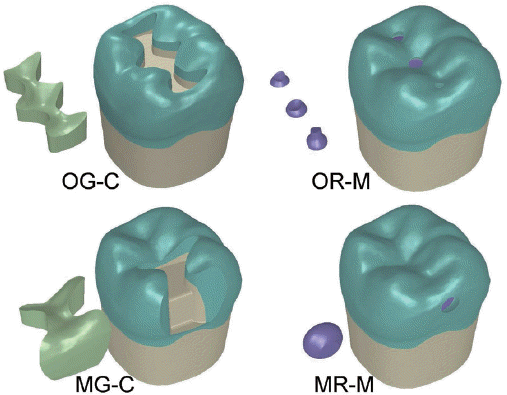
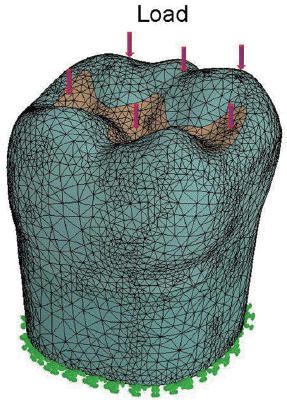
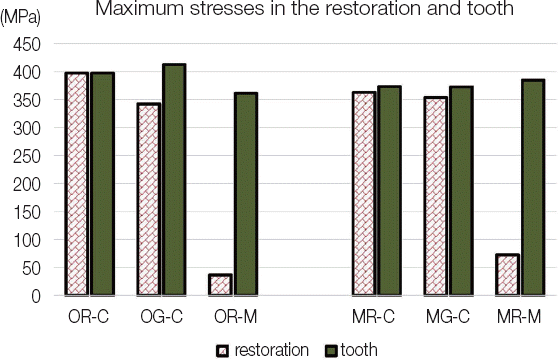




 PDF
PDF Citation
Citation Print
Print



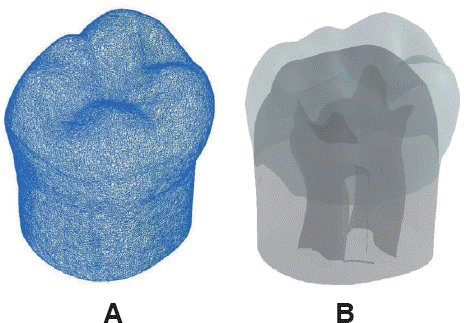
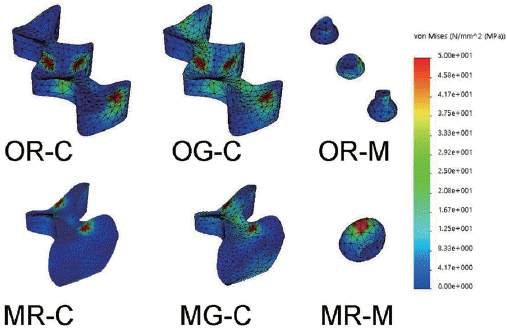
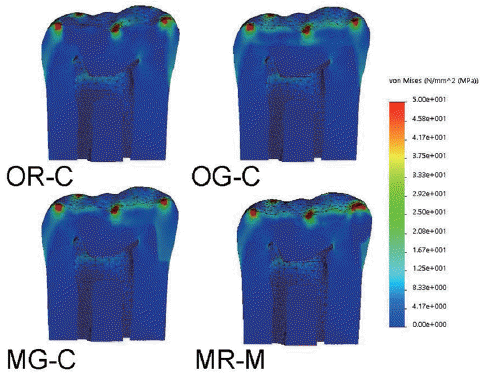
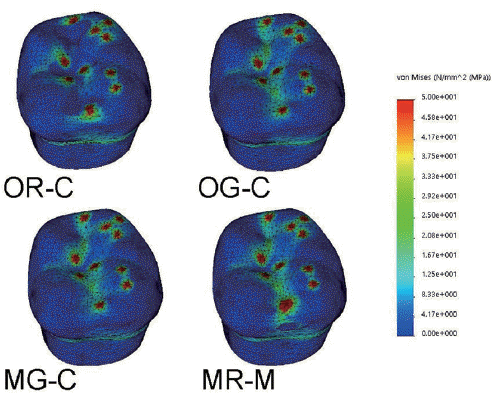
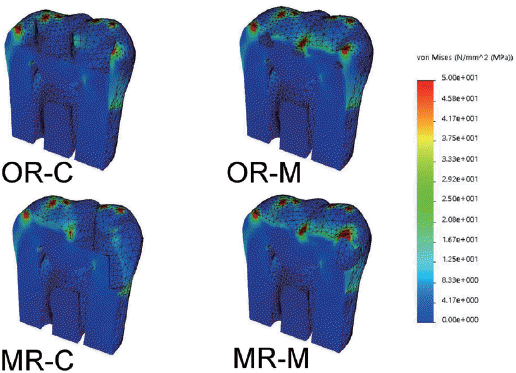
 XML Download
XML Download